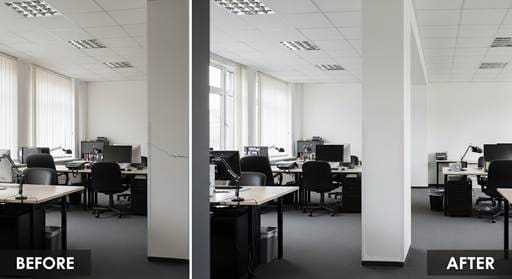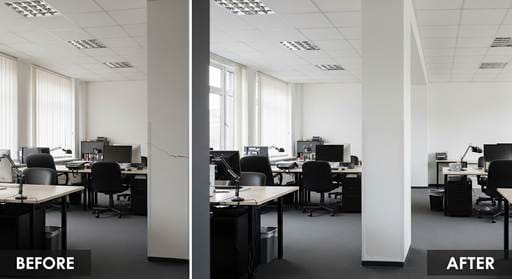For any commercial tenant, the term “dilapidations” can conjure images of unforeseen costs and complex legal battles at the end of a lease.
Far from being a niche legal issue, dilapidations represent a significant financial liability and a crucial aspect of responsible property management that often catches businesses off guard.
Understanding your obligations from the outset, and taking proactive steps throughout your tenancy, is key to avoiding costly surprises when your lease comes to an end.
We’ve guided countless businesses through the intricacies of property maintenance and compliance. We understand that while day-to-day operations take priority, ignoring dilapidations can lead to substantial financial penalties and unwelcome disputes.
Our expertise allows us to partner with commercial tenants, ensuring their properties are maintained to the required standard, mitigating risks, and providing clarity in what can be a daunting process.
This article serves as a practical guide for commercial tenants, demystifying dilapidations, highlighting common pitfalls, and demonstrating how a strategic, proactive approach supported by expert facility management can help you navigate this labyrinth effectively and protect your bottom line.
What Exactly Are Dilapidations?
Dilapidations refers to the disrepair of a premises, usually in the context of a commercial lease, where a tenant is liable for maintaining and returning the property in a given condition. It involves breaches of the tenant’s repairing covenants outlined in the lease contract, both during the lease term and at its end.
Repair: Maintain the property in a specific state of repair. This can range from “good and substantial repair” to maintaining it in the condition it was at the start of the lease (often referenced by a Schedule of Condition)
Decorate: Re-decorate the property periodically or at the end of the term.
Yield Up: Return the property to the landlord at the end of the lease in a specified condition, often including obligations to remove tenant alterations or fixtures (reinstatement).
Comply with Statutory Obligations: Ensure the property adheres to all relevant health, safety, and environmental legislation.
When a lease expires or is assigned, the landlord will often serve a “Schedule of Dilapidations” – a detailed document outlining alleged breaches of these covenants and the estimated cost to remedy them.
This can include anything from a leaky roof and broken air conditioning systems to faded paint, damaged flooring, or unremoved partition walls.

Why Dilapidations Are So Often a Costly Surprise
The reason many commercial tenants face unexpected high costs stems from a few common oversights:
- Ignoring the Lease Details: The lease agreement is the definitive document. Many tenants fail to fully understand their specific repair, decorating, and reinstatement clauses at the start of the tenancy or throughout its duration.
- Lack of Proactive Maintenance: Adopting a “fix it when it breaks” mentality rather than a planned preventative maintenance approach means issues accumulate, becoming more extensive and expensive to remedy at the lease end.
- No Schedule of Condition: Without a detailed “Schedule of Condition” agreed upon at the commencement of the lease (documenting the property’s state at the start), it’s difficult to argue that certain existing defects are not the tenant’s responsibility.
- Leaving it Too Late: Waiting until the last few months of a lease to address dilapidations leaves little time for competitive tendering, efficient works, and proper negotiation, often leading to rushed, expensive solutions or a cash settlement to the landlord.
- Underestimating Reinstatement Costs: Removing tenant-installed fixtures, fittings, or alterations (e.g., partition walls, specialist electrical installations) can be far more complex and costly than initially anticipated.
Avoiding the Pitfalls: A Proactive Tenant’s Strategy
The good news is that with a strategic, proactive approach, commercial tenants can significantly reduce their dilapidations liability and avoid those painful last-minute surprises.
- Understand Your Lease from Day One:
Action: Before signing, or as early in your tenancy as possible, thoroughly review the repair, decorating, reinstatement, and compliance clauses.
FPM Facility Services’ Role: While we don’t offer legal advice, understanding your lease allows us to tailor maintenance plans that align with your specific covenants, ensuring efforts are directed where they matter most.
- Get a Schedule of Condition (or create one retrospectively):
Action: Ideally, before signing the lease, commission a detailed photographic and written Schedule of Condition. This acts as a baseline, limiting your repair obligations to a similar condition. If not done, consider commissioning a dilapidations assessment well before lease end to get an early understanding of your potential liabilities.
FPM Facility Services’ Role: We can conduct comprehensive site surveys to assess the current condition of your property’s key systems and fabric. This helps identify existing issues and provides a factual basis for planning any necessary works against your lease obligations.
- Implement a Robust Planned Preventative Maintenance (PPM) Programme:
Action: Integrate a systematic PPM schedule throughout your tenancy. This ensures critical building systems (electrical, plumbing, roofing) are regularly inspected, serviced, and repaired proactively. Small issues are addressed before they become large, costly dilapidations claims.
FPM Facility Services’ Role: We design and implement tailored PPM programmes that keep your property in good order. This includes routine checks of all building elements, from electrical installations (EICR, PAT) and lighting to plumbing and fabric repairs. Our proactive approach minimises the build-up of maintenance issues that would otherwise form part of a dilapidations claim.
- Manage Alterations and Reinstatement Early:
Action: Keep clear records of all tenant alterations and understand your reinstatement obligations for each. If you have significant alterations, consider engaging a dilapidations specialist well in advance of lease expiry to plan for reinstatement.
FPM Facility Services’ Role: We can manage the safe and compliant removal of tenant alterations and reinstatement of the property to its original layout, including electrical reconfigurations, partition removal, and re-decoration, ensuring compliance with both lease terms and safety regulations.
- Engage Early with a Dilapidations Specialist (and your FM partner):
Action: Approximately 12-18 months before lease expiry, engage a specialist dilapidations surveyor. They will provide an assessment of your likely liability and can help negotiate with the landlord. Crucially, involve your chosen facilities management partner in this process.
FPM Facility Services’ Role: We work collaboratively with your dilapidations surveyor. Once the “terminal schedule of dilapidations” is received, we can provide accurate, competitive quotes for all necessary repair, decoration, and reinstatement works. Our ability to manage multiple trades and particularly with our in-house electrical expertise this streamlines the process and ensures works are completed efficiently and to a high standard.
The FPM Advantage: Your Partner in Dilapidations Management

For commercial tenants, navigating dilapidations is complex, but it doesn’t have to be overwhelming. Weact as your trusted partner, providing:
- Proactive Maintenance Solutions: Our PPM programmes significantly reduce the accumulation of dilapidations issues throughout your tenancy.
- Expert Electrical Services: Our in-house electricians ensure all electrical compliance and reinstatement works are carried out safely and efficiently, a common and costly area of dilapidations.
- Comprehensive Project Management: We can coordinate and execute all necessary repair, decoration, and reinstatement works, offering a single point of contact and ensuring quality control.
- Cost Efficiency: By managing works effectively and proactively, we help you avoid inflated landlord claims and costly last-minute scrambles.
- Peace of Mind: Knowing your property is maintained to lease standards and that you have expert support for lease-end obligations allows you to focus on your core business.
Protecting Your Investment, Avoiding Surprises
Dilapidations are a significant financial consideration for commercial tenants, but they don’t have to be a source of constant worry.
By understanding your lease, embracing proactive maintenance, and partnering with an experienced facility management provider like FPM Facility Services, you can approach lease expiry with confidence, fulfilling your obligations efficiently and avoiding those costly, unwelcome surprises.
If you’re a commercial tenant seeking clarity on your dilapidations liabilities or require expert support for property maintenance and lease-end works, we invite you to contact us. Let us help you transform potential problems into manageable solutions and protect your business’s financial future.
Telephone: 01582 484020
Mail: service@f-p-m.co.uk






